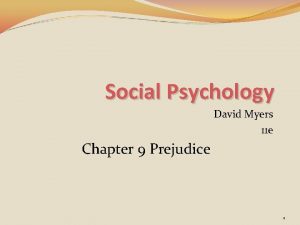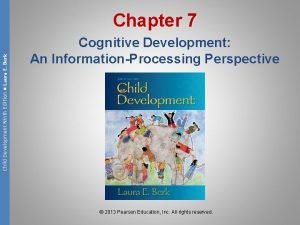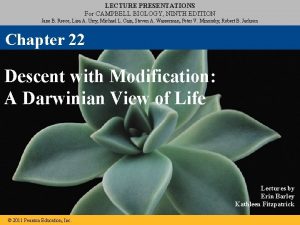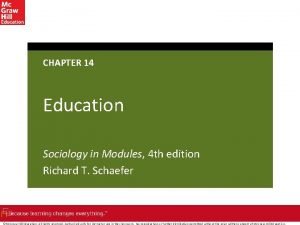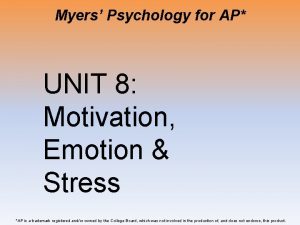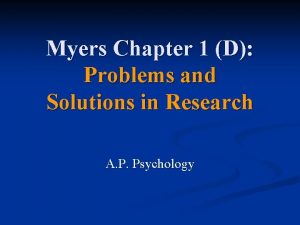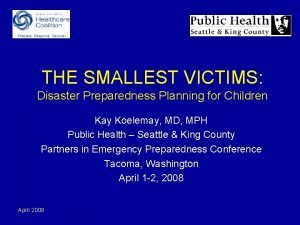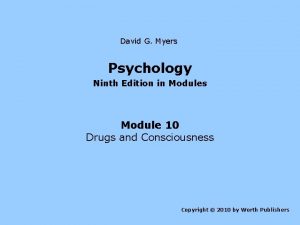Psychology Ninth Edition in Modules David Myers Power










![Synapse [SIN-aps] a junction between the axon tip of the sending neuron and the Synapse [SIN-aps] a junction between the axon tip of the sending neuron and the](https://slidetodoc.com/presentation_image/033bbd9fe1d87c8938c078e1a73b3664/image-11.jpg)
























- Slides: 35

Psychology, Ninth Edition in Modules David Myers Power. Point Slides Aneeq Ahmad Henderson State University Worth Publishers, © 2010

The Biology of Mind

Neural Communication § Neurons § How Neurons Communicate § How Neurotransmitters Influence Us The Nervous System § The Peripheral Nervous System § The Central Nervous System The Endocrine System

Neural Communication The body’s information system is built from billions of interconnected cells called neurons.

Neural Communication Neurobiologists and other investigators understand that humans and animals operate similarly when processing information. Note the similarities in the above brain regions, which are all engaged in information processing.

Neuron A nerve cell, or a neuron, consists of many different parts.

Parts of a Neuron Cell Body: Life support center of the neuron. Dendrites: Branching extensions at the cell body. Receive messages from other neurons. Axon: Long single extension of a neuron, covered with myelin [MY-uh-lin] sheath to insulate and speed up messages through neurons. Terminal Branches of axon: Branched endings of an axon that transmit messages to other neurons.

Action Potential A neural impulse. A brief electrical charge that travels down an axon and is generated by the movement of positively charged atoms in and out of channels in the axon’s membrane.

Threshold: Each neuron receives excitatory and inhibitory signals from many neurons. When the excitatory signals minus the inhibitory signals exceed a minimum intensity (threshold) the neuron fires an action potential.

Action Potential Properties All-or-None Response: A strong stimulus can trigger more neurons to fire, and to fire more often, but it does not affect the action potentials strength or speed. Intensity of an action potential remains the same throughout the length of the axon.
![Synapse SINaps a junction between the axon tip of the sending neuron and the Synapse [SIN-aps] a junction between the axon tip of the sending neuron and the](https://slidetodoc.com/presentation_image/033bbd9fe1d87c8938c078e1a73b3664/image-11.jpg)
Synapse [SIN-aps] a junction between the axon tip of the sending neuron and the dendrite or cell body of the receiving neuron. This tiny gap is called the synaptic gap or cleft.

Neurotransmitters (chemicals) released from the sending neuron travel across the synapse and bind to receptor sites on the receiving neuron, thereby influencing it to generate an action potential.

Reuptake Neurotransmitters in the synapse are reabsorbed into the sending neurons through the process of reuptake. This process applies the brakes on neurotransmitter action.

How Neurotransmitters Influence Us Serotonin pathways are involved with mood regulation. From Mapping the Mind, Rita Carter, © 1989 University of California Press

Dopamine Pathways Dopamine pathways are involved with diseases such as schizophrenia and Parkinson’s disease. From Mapping the Mind, Rita Carter, © 1989 University of California Press

Neurotransmitters

Lock & Key Mechanism Neurotransmitters bind to the receptors of the receiving neuron in a key-lock mechanism.

Agonists

Antagonists

Nervous System Central Nervous System (CNS) Peripheral Nervous System (PNS)

The Nervous System: Consists of all the nerve cells. It is the body’s speedy, electrochemical communication system. Central Nervous System (CNS): the brain and spinal cord. Peripheral Nervous System (PNS): the sensory and motor neurons that connect the central nervous system (CNS) to the rest of the body.

The Nervous System

Kinds of Neurons Sensory Neurons carry incoming information from the sense receptors to the CNS. Motor Neurons carry outgoing information from the CNS to muscles and glands. Interneurons connect the two neurons. Interneuron Neuron (Unipolar) Sensory Neuron (Bipolar) Motor Neuron (Multipolar)

Peripheral Nervous System Somatic Nervous System: The division of the peripheral nervous system that controls the body’s skeletal muscles. Autonomic Nervous System: Part of the PNS that controls the glands and other muscles.

The Nerves consist of neural “cables” containing many axons. They are part of the peripheral nervous system and connect muscles, glands, and sense organs to the central nervous system.

Autonomic Nervous System (ANS) Sympathetic Nervous System: Division of the ANS that arouses the body, mobilizing its energy in stressful situations. Parasympathetic Nervous System: Division of the ANS that calms the body, conserving its energy.

Autonomic Nervous System (ANS) Sympathetic NS “Arouses” (fight-or-flight) Parasympathetic NS “Calms” (rest and digest)

Central Nervous System The Brain and Neural Networks Interconnected neurons form networks in the brain. Theses networks are complex and modify with growth and experience. Complex Neural Network

Central Nervous System The Spinal Cord and Reflexes Simple Reflex

The Endocrine System is the body’s “slow” chemical communication system. Communication is carried out by hormones synthesized by a set of glands.

Hormones are chemicals synthesized by the endocrine glands that are secreted in the bloodstream. Hormones affect the brain and many other tissues of the body. For example, epinephrine (adrenaline) increases heart rate, blood pressure, blood sugar, and feelings of excitement during emergency situations.

Pituitary Gland Is called the “master gland. ” The anterior pituitary lobe releases hormones that regulate other glands. The posterior lobe regulates water and salt balance.

Thyroid & Parathyroid Glands Regulate metabolic and calcium rate.

Adrenal Glands Adrenal glands consist of the adrenal medulla and the cortex. The medulla secretes hormones (epinephrine and norepinephrine) during stressful and emotional situations, while the adrenal cortex regulates salt and carbohydrate metabolism.

Gonads Sex glands are located in different places in men and women. They regulate bodily development and maintain reproductive organs in adults.
 Psychology ninth edition david g myers
Psychology ninth edition david g myers Psychology ninth edition david g myers
Psychology ninth edition david g myers Levels of analysis psychology
Levels of analysis psychology Psychology ninth edition in modules
Psychology ninth edition in modules Psychology eighth edition david g myers
Psychology eighth edition david g myers Reuptake psychology
Reuptake psychology Psychology tenth edition in modules
Psychology tenth edition in modules Social psychology ninth edition
Social psychology ninth edition Abnormal psychology ronald j comer 9th edition
Abnormal psychology ronald j comer 9th edition Social psychology myers
Social psychology myers Macroeconomics mankiw 9th edition
Macroeconomics mankiw 9th edition Human anatomy & physiology edition 9
Human anatomy & physiology edition 9 Biology ninth edition
Biology ninth edition Child development laura berk 9th edition
Child development laura berk 9th edition Child development 9th edition
Child development 9th edition Biology ninth edition
Biology ninth edition Campbell ninth edition
Campbell ninth edition Sociology in modules 4th edition
Sociology in modules 4th edition Myers psychology unit 8
Myers psychology unit 8 Myers psychology for ap
Myers psychology for ap Myers' psychology for ap solutions
Myers' psychology for ap solutions Psychology in everyday life myers
Psychology in everyday life myers Myers' psychology for ap
Myers' psychology for ap Power triangle
Power triangle Catholic sixth commandment
Catholic sixth commandment The sixth and ninth commandments
The sixth and ninth commandments Ninth grade vocabulary
Ninth grade vocabulary Whats ramadam
Whats ramadam William blount ninth grade academy
William blount ninth grade academy Lower ninth ward
Lower ninth ward 3 course french classical menu
3 course french classical menu Ninth district pta
Ninth district pta Mis chapter 6
Mis chapter 6 Using mis 10th edition
Using mis 10th edition Organic chemistry david klein 3rd edition
Organic chemistry david klein 3rd edition David klein organic chemistry
David klein organic chemistry









